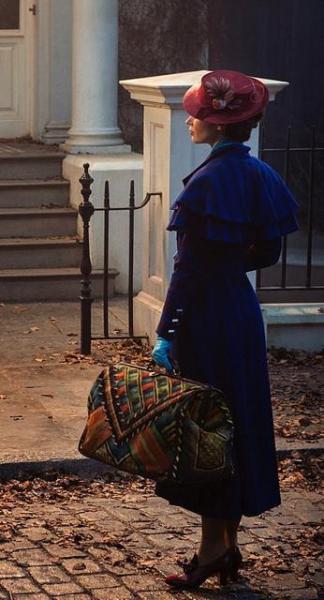Let’s get the review portion out of the way: I loved it. My whole family did. We’ve been singing Trip a Little Light Fantastic and A Cover Is Not The Book for days now. This movie is everything a Mary Poppins sequel should be: colorful, joy-filled, and full of surprises. The visuals did not disappoint, either. With all the recent evolution in digital animation, you expect any new Disney creation to overwhelm your expectations, and they nailed it. It had all the fun and fantasy of the first movie, but with the sophistication that we know modern technology can deliver.
But with greater sophistication comes more complexity. An evolving storyline brings more layers of meaning, more highly developed characters, more nuance. This truth played out in several ways throughout the film. For instance, Michael Banks is not just an overworked, disengaged father, like his own before him. He is a young widow, utterly heartbroken, and in need of some hope and joy–the likes of which only Mary Poppins can bring.
And then there’s Jane… am I the only one that thinks Jane Banks is a lesbian? Even until the very end, she’s all “ha ha, no, we’re just friends.” And poor Jack (Lin Manuel-Miranda’s character) is just hanging in there, hopeful and undaunted… the guy with no gaydar. I’m not saying there weren’t modern, independent straight girls wearing the bob and the pantsuits back then, but come on. She OWNED that pantsuit. And maybe her orientation doesn’t matter much to the story, but it would certainly add another layer of nuance if she were at least bi-curious.
And then, there were the blasts from the past… When Michael set the box of old things from the attic out on the curb, I heard my daughter gasp. What? I whisper-yelled in the theater. The ribbon! The mom’s ribbon! she whisper-yelled back. And sure enough– there, hanging over the edge of the box of junk: the elder Mrs. Banks’ suffragette sash, from the old movie. (Stop, I’ve got something in my eye). And THEN. Then Jane goes off with her protest signs, to join the march with the labor union. It tells the truth about the slow, forward march of progress; a mother’s legacy; and the things we carry on. There was nothing that deep in the original.
But the deeper narrative fault line is most evident with Mary herself. Julie Andrews’ original Mary was no-nonsense, to be sure. But she was bright, sunny and smiling, always. Many have noted that Emily Blunt’s Mary comes in stronger with the snark–perhaps more true to the ‘Mary’ of the original P.L. Travers book series. You know, before Disney got hold of her.
She’s not just sassy though. In several different scenes– in the midst of all the color and chaos and hilarity– the camera catches her in a quiet moment… looking off into the distance with an expression that, for all its complexity, can only be called what it is: a deep sadness.
Though Practically Perfect in Every Way, Mary Poppins betrays that one quality of imperfect humanity: sometimes, for all her bubbly pluck, she gets sad.

Where does that sadness come from? Maybe there’s a backstory involving romance and heartbreak. Maybe she misses her mother. Maybe she can’t go home again. We are left guessing. But if I had one guess, I know what it would be. Mary is sad because, as much as she loves the Banks family, and as much as they are a part of her, she doesn’t get to stay. She never does.
To that I can only say– sister, I feel your pain.
Now that the holidays are over, it is reality time: I finished packing up my office today, and Sunday is my last day at Saint Andrew, where I’ve served as senior pastor for more than five years. My life is in boxes. I’m doing things like suspending email accounts, clearing files, turning in keys and credit cards. And nothing says finality like empty bookshelves.
Maybe at another time, the particular sadness of Mary Poppins might have struck me in another way–the long lost love, or the generic longing for simpler times. But for just this moment in my life, I see her blues as a mirror to my own: it is the face of one who has come to serve a particular purpose, but knows when it’s time to go.
Of course, leaving is not all sadness. There’s a lot of joy in what’s next, and a peace about time well spent here. Like the movie itself, even the chaos of transition is filled with color and music. But ask any pastor who’s ever loved a church and left it. They will tell you it’s a real and raw thing, to come and go with a calling. There’s almost a sadness even on arrival, knowing that we’ll have to leave someday. Some Spirit wind blows us to the door–umbrella in hand (or broomstick, as it were)–and we know the same wind will carry us out again, eventually.
But not as we were.
Of course Mary Poppins is sad. In fact, how did we not see it the first time, all those years ago? She has a deep and abiding love for that family, one that carries into the next generation. She changed their lives at a time when they needed it–and “perfect” as she was on arrival, they shaped in her in some fundamental way as well. They softened her edges. They gave her new songs to sing. Most of all, they gave her a place and a purpose. But she knew she couldn’t stay. She always knew that wind would come back and carry her off again. To some other place, some other hurting family in need of her particular magic.
The business of loving and leaving, after all, is not for the faint of heart. But it’s we are called to do, wherever that Spirit wind blows us. We wear the sash, bear the sign, or carry the lamp-lighting torch of those that came before us. We trust that those we leave behind will go right on holding the banner and burning the light behind us. And most of all, we trust that the wind knows what it’s doing.












